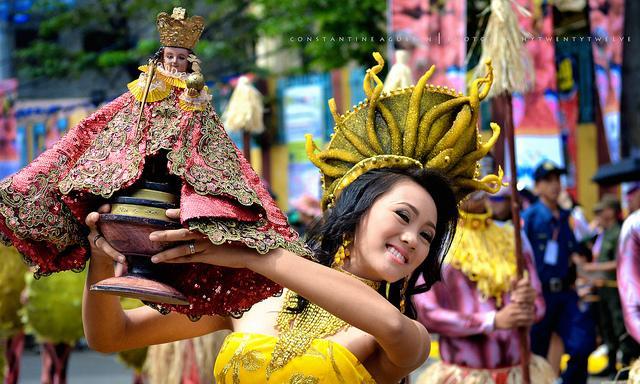
The Sinulog is an annual festival held on the third Sunday of January in Cebu City, Philippines. The festival commemorates the Cebuano people's pagan origin and their acceptance of Roman Catholicism.
The festival features a street parade with participants in bright colored costumes dancing to the rhythm of drums, trumpets and native gongs. Smaller versions of the festival are held in various parts of the province, also to celebrate and honor the Santo Niño. There is also a "Sinulog sa Kabataan" performed by the youths of Cebu a week before the parade. Recently, the festival has been promoted as a tourist attraction, with a contest featuring contingents from various parts of the country. The Sinulog Contest is usually held in the Cebu City Sports Complex.
 The Sinulog celebration lasts for nine days, culminating on the final day with the Sinulog Grand Parade. The day before the parade, the Fluvial Procession is held at dawn with a statue of the Santo Niño carried on a pump boat from Mandaue City to Cebu City, decked with hundreds of flowers and candles. The procession ends at the Basilica where a re-enactment of the Christianizing (that is, the acceptance of Roman Catholicism) of Cebu is performed. In the afternoon, a more solemn procession takes place along the major streets of the city, which last for hours due to large crowd participating in the event.
The Sinulog celebration lasts for nine days, culminating on the final day with the Sinulog Grand Parade. The day before the parade, the Fluvial Procession is held at dawn with a statue of the Santo Niño carried on a pump boat from Mandaue City to Cebu City, decked with hundreds of flowers and candles. The procession ends at the Basilica where a re-enactment of the Christianizing (that is, the acceptance of Roman Catholicism) of Cebu is performed. In the afternoon, a more solemn procession takes place along the major streets of the city, which last for hours due to large crowd participating in the event.
The word Sinulog comes from the Cebuano adverb sulog which roughly means "like water current movement;" it describes the forward-backward movement of the Sinulog dance. The dance consists of two steps forward and one step backward, done to the sound of drums. The dance is categorized into Sinulog-base, Free-Interpretation. Candle vendors at the Basilica continue to perform the traditional version of the dance when lighting a candle for the customer, usually accompanied by songs in the native language.

The Sinulog dance steps are believed to originate from Rajah Humabon's adviser, Baladhay. It was during Humabon's grief when Baladhay was driven sick. Humabon ordered his native tribe to bring Baladhay into a room where the Santo Niño was enthroned, along with the other pagan gods of the native Cebuanos. After a few days passed, Baladhay was heard shouting and was found dancing with utmost alertness. Baladhay was questioned as to why was he awake and shouting. Pointing to the image of the Santo Niño, Baladhay explained that he had found on top of him a small child trying to wake him and tickling him with the midrib of the coconut. Greatly astonished, he scared the child away by shouting. The little child got up and started making fun of Baladhay. In turn, Baladhay danced with the little child and explained that he was dancing the movements of the river. To this day, the two-steps forward, one-step backward movement is still used by Santo Niño devotees who believe that it was the Santo Niño's choice to have Baladhay dance.
 Since 1521, devotion to the Santo Niño has grown and has taken root in Philippine popular piety, particularly in the Visayas; pilgrims from different parts of Cebu and the rest of the Philippines make their yearly journey to the church to take part in the procession and festival. Starting in 1980, the Cebu City government organized the Sinulog Festival and eventually gave incentives to tribal dance groups. The first Sinulog parade was held in 1980, organized by Dávid Odilao, then Regional Director of the Ministry of Sports and Youth Development. The parade was composed of students dressed in Moro costumes, dancing the Sinulog to the beating of drums.
Since 1521, devotion to the Santo Niño has grown and has taken root in Philippine popular piety, particularly in the Visayas; pilgrims from different parts of Cebu and the rest of the Philippines make their yearly journey to the church to take part in the procession and festival. Starting in 1980, the Cebu City government organized the Sinulog Festival and eventually gave incentives to tribal dance groups. The first Sinulog parade was held in 1980, organized by Dávid Odilao, then Regional Director of the Ministry of Sports and Youth Development. The parade was composed of students dressed in Moro costumes, dancing the Sinulog to the beating of drums.
The idea caught on, and thus, under the direction of the Cebu City Mayor Florentino Solon with the help of several influential Cebuanos, Odilao turned over the Sinulog project to the Cebu City Historical Committee under Kagawad Jesus Garcia. It was the task of the Committee to conceptualize the Sinulog festival and make it into a yearly event from then on.
In 1981, the following year, the concept of the Sinulog Parade was actualized involving not just Cebu but also representatives from other provinces in the Philippines . Marking its difference from another popular festival, the Ati-Atihan in Aklan, the Sinulog focuses not on the ritual itself but on the historical aspects of the dance, which, as it has been said, represents the link the country's embrace of Christian faith.










